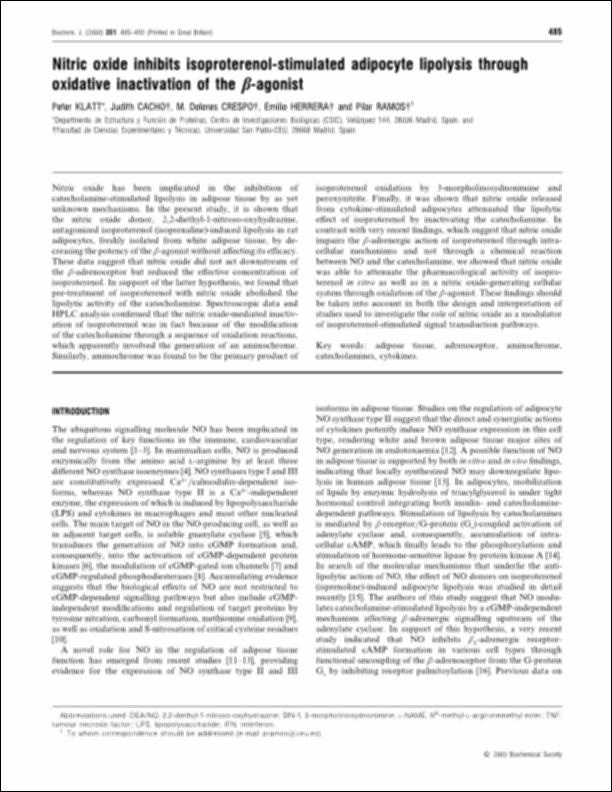Please use this identifier to cite or link to this item:
http://hdl.handle.net/10637/589Nitric oxide inhibits isoproterenol-stimulated adipocyte lipolysis through oxidative inactivation of the beta-agonist.
| Title: | Nitric oxide inhibits isoproterenol-stimulated adipocyte lipolysis through oxidative inactivation of the beta-agonist. |
| Authors : | Herrera Castillón, Emilio. Cacho Herrero, Judith Crespo, María Dolores Ramos Álvarez, María del Pilar |
| Abstract: | Nitric oxide has been implicated in the inhibition of catecholamine-stimulated lipolysis in adipose tissue by as yet unknown mechanisms. In the present study, it is shown that the nitric oxide donor, 2,2-diethyl-1-nitroso-oxyhydrazine, antagonized isoproterenol (isoprenaline)-induced lipolysis in rat adipocytes, freshly isolated from white adipose tissue, by decreasing the potency of the b-agonist without affecting its efficacy. These data suggest that nitric oxide did not act downstream of the b-adrenoceptor but reduced the effective concentration of isoproterenol. In support of the latter hypothesis, we found that pre-treatment of isoproterenol with nitric oxide abolished the lipolytic activity of the catecholamine. Spectroscopic data and HPLC analysis con®rmed that the nitric oxide-mediated inactivation of isoproterenol was in fact because of the modi®cation of the catecholamine through a sequence of oxidation reactions, which apparently involved the generation of an aminochrome. Similarly, aminochrome was found to be the primary product of isoproterenol oxidation by 3-morpholinosydnonimine and peroxynitrite. Finally, it was shown that nitric oxide released from cytokine-stimulated adipocytes attenuated the lipolytic effect of isoproterenol by inactivating the catecholamine. In contrast with very recent ®ndings, which suggest that nitric oxide impairs the b-adrenergic action of isoproterenol through intracellular mechanisms and not through a chemical reaction between NO and the catecholamine, we showed that nitric oxide was able to attenuate the pharmacological activity of isoproterenol in itro as well as in a nitric oxide-generating cellular system through oxidation of the b-agonist. These ®ndings should be taken into account in both the design and interpretation of studies used to investigate the role of nitric oxide as a modulator of isoproterenol-stimulated signal transduction pathways. |
| Description: | En: Biochemical journal, ISSN 0264-6021 2000. Vol. 351 (Pt 2), pp 485-493 |
| URI: | http://hdl.handle.net/10637/589 |
| Rights : | http://creativecommons.org/licenses/by-nc-nd/4.0/deed.es |
| Issue Date: | 19-Sep-2000 |
| Center : | Universidad San Pablo-CEU |
| Appears in Collections: | Facultad de Farmacia |
Items in DSpace are protected by copyright, with all rights reserved, unless otherwise indicated.


